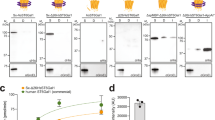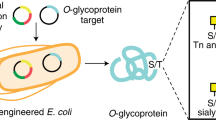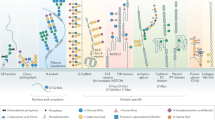Abstract
In higher organisms, the functions of many proteins are modulated by post-translational modifications (PTMs). Glycosylation is by far the most diverse of the PTM processes. Natural protein production methods typically produce PTM or glycoform mixtures within which function is difficult to dissect or control. Chemical tagging methods allow the precise attachment of multiple glycosylation modifications to bacterially expressed (bare) protein scaffolds, allowing reconstitution of functionally effective mimics of glycoproteins in higher organisms. In this way combining chemical control of PTM with readily available protein scaffolds provides a systematic platform for creating probes of protein–PTM interactions. This protocol describes the modification of Cys residues in proteins using glycomethanethiosulfonates and glycoselenenylsulfides and the modification of azidohomoalanine residues, introduced by Met replacement using auxotrophic Met(−) Escherichia coli strains, with glycoalkynes and the combination of these techniques for the creation of dual-tagged proteins. Each glycosylation procedure outlined in this protocol can be achieved in half a day.
This is a preview of subscription content, access via your institution
Access options
Subscribe to this journal
Receive 12 print issues and online access
$259.00 per year
only $21.58 per issue
Buy this article
- Purchase on Springer Link
- Instant access to full article PDF
Prices may be subject to local taxes which are calculated during checkout





Similar content being viewed by others
References
Wold, F. In vivo chemical modification of proteins (post-translational modification). Ann. Rev. Biochem. 50, 783–814 (1981).
Walsh, C.T., Garneau-Tsodikova, S. & Gatto, G.J. Jr. Protein posttranslational modifications: the chemistry of proteome diversifications. Angew. Chem. Int. Ed. 44, 7342–7372 (2005).
Walsh, C.T. Posttranslational Modification of Proteins: Expanding Nature's Inventory (Roberts and Co. Press, Englewood, Colorado, 2005).
Rademacher, T.W., Parekh, R.B. & Dwek, R.A. Glycobiology. Annu. Rev. Biochem. 57, 785–838 (1988).
Dwek, R.A. Glycobiology: toward understanding the function of sugars. Chem. Rev. 6, 683–720 (1996).
Rudd, P.M. et al. Glycoforms modify the dynamic stability and functional activity of an enzyme. Biochemistry 33, 17–22 (1994).
Hamilton, S.R. et al. Humanization of yeast to produce complex terminally sialylated glycoproteins. Science 313, 1441–1443 (2006).
Li, H. et al. Optimization of humanized IgGs in glycoengineered Pichia pastoris. Nat. Biotechnol. 24, 210–215 (2006).
Bobrowicz, P. et al. Engineering of an artificial glycosylation pathway blocked in core oligosaccharide assembly in the yeast Pichia pastoris: Production of complex humanized glycoproteins with terminal galactose. Glycobiology 14, 757–766 (2004).
Hamilton, S.R. et al. Production of complex human glycoproteins in yeast. Science 301, 1244–1246 (2003).
Xie, J. & Schultz, P.G. A chemical toolkit for proteins—an expanded genetic code. Nat. Rev. Mol. Cell Biol. 7, 775–782 (2006).
Zhang, Z. et al. A new strategy for the synthesis of glycoproteins. Science 303, 371–373 (2004).
Xu, R. et al. Site-specific incorporation of the mucin-type N-acetylgalactosamine-β-O-threonine into protein in Escherichia coli. J. Am. Chem. Soc. 126, 15654–15655 (2004).
van Kasteren, S.I., Garnier, P.G. & Davis, B.G. Chemical methods for mimicking post-translational modifications. in Protein Engineering (Springer Verlag, Berlin and Heidelberg, 2007).
Davis, B.G. Synthesis of glycoproteins. Chem. Rev. 102, 579–601 (2002).
Liu, L., Bennett, C.S. & Wong, C.H. Advances in glycoprotein synthesis. Chem. Commun. 21–33 (2006).
Muir, T.W. Semisynthesis of proteins by expressed protein ligation. Annu. Rev. Biochem. 72, 249–289 (2003).
Saxon, E., Armstrong, J.I. & Bertozzi, C.R. A 'traceless' Staudinger ligation for the chemoselective synthesis of amide bonds. Org. Lett. 2, 2141–2143 (2000).
van Kasteren, S.I. et al. Expanding the diversity of chemical protein modification allows post-translational mimicry. Nature 446, 1105–1109 (2007).
Gamblin, D.P. et al. Glycosyl phenylthiosulfonates (Glyco-PTS): novel reagents for glycoprotein synthesis. Org. Biomol. Chem. 1, 3642–3644 (2003).
Gamblin, D.P. et al. Glyco-SeS: selenenylsulfide-mediated protein glycoconjugation—a new strategy in post-translational modification. Angew. Chem. Int. Ed. 43, 828–833 (2004).
Davis, B.G., Lloyd, R.C. & Jones, J.B. Controlled site-selective glycosylation of proteins by a combined site- directed mutagenesis and chemical modification approach. J. Org. Chem. 63, 9614–9615 (1998).
Hermanson, G.T. Bioconjugate Techniques 1st edn. (Academic Press, San Diego, California, 1996).
Davis, B.G., Maughan, M.A.T., Green, M.P., Ullman, A. & Jones, J.B. Glycomethanethiosulfonates: powerful reagents for protein glycosylation. Tetrahedron Asymmetry 11, 245–262 (2000).
Swanwick, R.S., Daines, A.M., Flitsch, S.L. & Allemann, R.K. Synthesis of homogenous site-selectively glycosylated proteins. Org. Biomol. Chem. 3, 572–574 (2005).
MacMillan, D., Bill, R.M., Sage, K.A., Fern, D. & Flitsch, S.L. Selective in vitro glycosylation of recombinant proteins: semi-synthesis of novel homogeneous glycoforms of human erythropoietin. Chem. Biol. 8, 133–145 (2001).
Davis, B.G., Lloyd, R.C. & Jones, J.B. Controlled site-selective protein glycosylation for precise glycan structure-catalytic activity relationships. Bioorg. Med. Chem. 8, 1527–1535 (2000).
Tornøe, C.W., Christensen, C. & Meldal, M. Peptidotriazoles on solid phase: [1,2,3]-Triazoles by regiospecific copper(I)-catalyzed 1,3-dipolar cycloadditions of terminal alkynes to azides. J. Org. Chem. 67, 3057–3064 (2002).
Demko, Z.P. & Sharpless, K.B. A click chemistry approach to tetrazoles by huisgen 1,3-dipolar cycloaddition: synthesis of 5-acyltetrazoles from azides and acyl cyanides. Angew. Chem. Int. Ed. 41, 2113–2116 (2002).
Kolb, H.C., Finn, M.G. & Sharpless, K.B. Click chemistry: diverse chemical function from a few good reactions. Angew. Chem. Int. Ed. 40, 2005–2021 (2001).
Deiters, A. & Schultz, P.G. In vivo incorporation of an alkyne into proteins in Escherichia coli. Bioorg. Med. Chem. Lett. 15, 1521–1524 (2005).
Deiters, A. et al. Adding amino acids with novel reactivity to the genetic code of Saccharomyces cerevisiae. J. Am. Chem. Soc. 125, 11782–11783 (2003).
Lin, P.C. et al. Site-specific protein modification through Cu-I-catalyzed 1,2,3-triazole formation and its implementation in protein microarray fabrication. Angew. Chem. Int. Ed. 45, 4286–4290 (2006).
Yang, W., Hendrickson, W.A., Crouch, R.J. & Satow, Y. Structure of ribonuclease H phased at 2 A resolution by MAD analysis of the selenomethionyl protein. Science 249, 1398–1405 (1990).
Kiick, K.L., Weberskirch, R. & Tirrell, D.A. Identification of an expanded set of translationally active methionine analogues in Escherichia coli. FEBS Lett. 502, 25–30 (2001).
Kiick, K.L. & Tirrell, D.A. Protein engineering by in vivo incorporation of non-natural amino acids: control of incorporation of methionine analogues by methionyl-tRNA synthetase. Tetrahedron 56, 9487–9493 (2000).
Kiick, K.L., Saxon, E., Tirrell, D.A. & Bertozzi, C.R. Incorporation of azides into recombinant proteins for chemoselective modification by the Staudinger ligation. Proc. Natl. Acad. Sci. USA 99, 19–24 (2002).
Kohler, G. & Milstein, C. Continuous cultures of fused cells secreting antibody of predefined specificity. Nature 256, 495–497 (1975).
Bernardes, G.J., Gamblin, D.P. & Davis, B.G. The direct formation of glycosyl thiols from reducing sugars allows one-pot protein glycoconjugation. Angew. Chem. Int. Ed. 45, 4007–4011 (2006).
Bernardes, G.J. & Davis, B.G. Direct thionation of reducing sugars. Nat. Protoc. (2007) doi: 10.1038/nprot.2007.439.
Drummer, O.H., Routley, L. & Christophidis, N. Reversibility of disulfide formation. Biochem. Pharmacol. 36, 1197–1201 (1987).
Lee, B. & Richards, F.M. The interpretation of protein structures: estimation of static accessibility. J. Mol. Biol. 55, 379–380 (1971).
Glocker, M.O., Borchers, C., Fiedler, W., Suckau, D. & Przybylski, M. Molecular characterization of surface topology in protein tertiary structures by amino-acylation and mass spectrometric peptide mapping. Bioconjug. Chem. 5, 583–590 (1994).
Stabile, M.R. et al. Probing the specificity of the S1 binding site of M222 mutants of subtilisin B. lentus with boronic acid inhibitors. Bioorg. Med. Chem. Lett. 6, 2501–2506 (1996).
Van Hest, J.C., Kiick, K.L. & Tirrell, D.A. Efficient incorporation of unsaturated methionine analogues into proteins in vivo. J. Am. Chem. Soc. 122, 1282–1288 (2000).
Perrin, D.D. & Armarego, W.L.F. Purification of Laboratory Chemicals (Pergamon Press, Oxford, 1988).
Chan, T.R., Hilgraf, R., Sharpless, K.B. & Fokin, V.V. Polytriazoles as copper(I)-stabilizing ligands in catalysis. Org. Lett. 6, 2853–2855 (2004).
Bradford, M.M. A rapid and sensitive method for the quantitation of microgram quantities of protein utilizing the principle of protein dye binding. Anal. Biochem. 72, 248–254 (1976).
Acknowledgements
S.I.v.K. and H.B.K. contributed equally to this work.
Author information
Authors and Affiliations
Corresponding author
Ethics declarations
Competing interests
The glycol-SeS, glycol-MTS and glycol-CCHC methods are registered in patents held by the University of Oxford. These may afford authors of this work royalties from subsequent licensing and/or other arrangements in line with standard university practice.
Rights and permissions
About this article
Cite this article
van Kasteren, S., Kramer, H., Gamblin, D. et al. Site-selective glycosylation of proteins: creating synthetic glycoproteins. Nat Protoc 2, 3185–3194 (2007). https://doi.org/10.1038/nprot.2007.430
Published:
Issue Date:
DOI: https://doi.org/10.1038/nprot.2007.430
This article is cited by
-
Selective chemical protein modification
Nature Communications (2014)
-
QuaNCAT: quantitating proteome dynamics in primary cells
Nature Methods (2013)
-
Virus-like glycodendrinanoparticles displaying quasi-equivalent nested polyvalency upon glycoprotein platforms potently block viral infection
Nature Communications (2012)
Comments
By submitting a comment you agree to abide by our Terms and Community Guidelines. If you find something abusive or that does not comply with our terms or guidelines please flag it as inappropriate.



